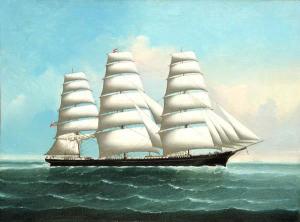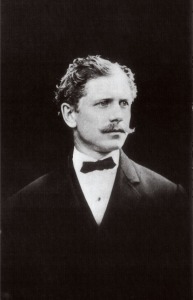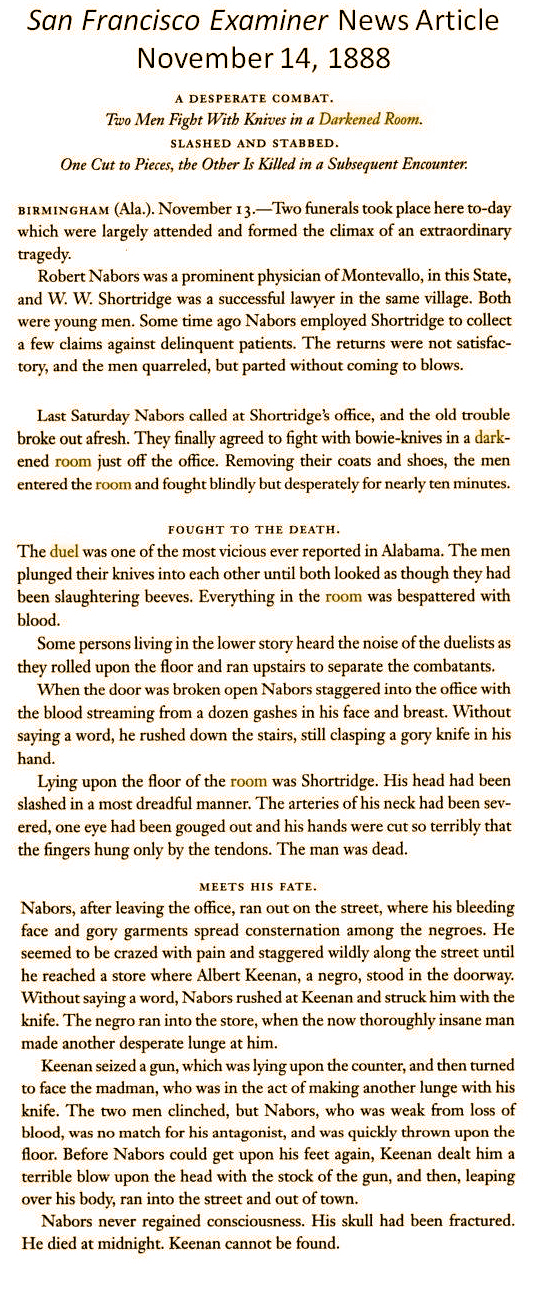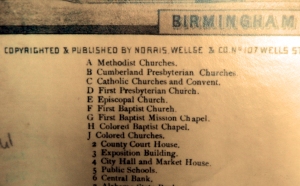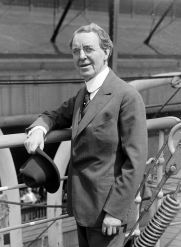Private Motheral Bonner’s Scrapbook

Student Intern Lisa Marie Mazenko
During the fall semester of 2016, Lisa Marie Mazenko a senior history major at the University of Alabama at Birmingham, served as a collections intern at the Birmingham History Center. During that time she processed over 650 recently donated artifacts including an interesting scrapbook of a World War II veteran. The following short essay about that scrapbook was written for this blog by Miss Mazenko.
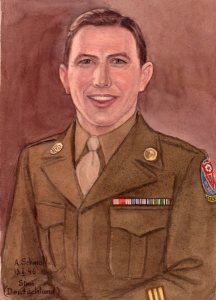
Private Motheral Bonner
A beautiful beige scrapbook recently donated to the Birmingham History Center documents the military life of Private Motheral Bonner. Before enlisting, Bonner was an insulation worker, with no formal education beyond grammar school. Bonner was thirty-two years old when he enlisted on the tenth of April, 1944, for whatever the duration of the war might be plus an additional six months. One of his first military actions was to apply for dependency benefits for his wife Rosealee, whom he had married on the twenty-ninth of July in 1933 in Birmingham, Alabama.
Inside the scrapbook is a certificate announcing Bonner’s completion of an eight-week medical technician course in El Paso, Texas, on the tenth of October, 1944. There is also a graduation program from the school for medical department technicians at William Beaumont General Hospital. Bonner was assigned to the 28th Medical Regiment which served the 68th Station Hospital in Paris in 1945.

V Mail, short for Victory Mail, soldier’s letters would be censored and filmed to save space during transport, then printed to a small sheet of paper for delivery.
One of the more touching pieces in the scrapbook is a sheath of V-mail addressed to the Bonners from SG Cooley. Dated the twelfth of January, 1944, part of it reads: “Got a little card from you folks and mighty glad someone remembers me, cause it looks like my Uncle Sam has plumb forgot me. They got me stuck way out here in the Central Pacific…” This exchange would seem to contradict the popular media myth that all American soldiers during World War Two were enthusiastic patriots.
On a more humorous note (or not, depending on your point of view), the scrapbook contains two important newspaper clippings. The first is an article describing the daily life of GIs after the end of the war was declared, while they awaited being shipped home, with a handwritten note in the margin which reads: “This has been my kind of life for the past few months.” The second clipping is a short poem written by a one PFC David Ross which contains the line, “V-J Day’s here, well, lovely, fine—I’ll see you all in ’69.” Both of these newspaper clippings illustrate the frustration and boredom experienced by thousands of American troops stuck overseas, often for longer than a year, as they waited for transport home.
Telling Tommy About – W. Paul Pim
Sometimes stories for the History Center blog come from footnotes from research while doing other stories. Our feature story about the 1916 Typhoid Epidemic in the May, 2016 issue of the History Center’s Newsletter fits that bill. The City Commissioner who responded to the health crisis that year was John Randoph Hornady (1872-1948) who also lead efforts to fund schools and authored a book in 1921 about Birmingham history to celebrate the 50th anniversary of the founding of Birmingham. “The Story of Birmingham.” To illustrate his book, Hornady hired William Paul Pim, a cartoonist with the Birmingham News.
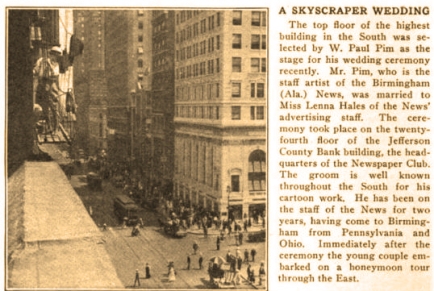
Cartoon Magazine, October, 1917, Page 572.
Pim’s story turned out to be as fascinating as the original newsletter article. Born December 1, 1885 in Freeport, Pennsylvania, Pim was the son of Ira Lester Pim and the former Mary Ella Dougherty. He graduated from the Cabot Institute in 1903, and studied photo engraving at Bissell College in Effingham, Illinois until 1906. Pim began his career in Cleveland, Ohio. He came to Birmingham in 1915 and worked as a staff artist for The Birmingham News. While here he met Lenna Hales, who worked in the advertising department. They were married at the Newspaper Club, located on the 24th floor of the Jefferson County Bank Building (City Federal Building) on July 14, 1917.

Fourth Estate (a newspaper for makers of newspapers), July 15, 1922
Pim soon began publishing a popular cartoon known as “Baby Mine,” which eventually was syndicated in over 60 newspapers in the Southeast. The single pane cartoon featured a young child who quoted humorous statements from adults, usually “maw” or “pop.” One occasion the Birmingham News held a contest offering a prize of one dollar for letters on “What your baby says,” and received 800 replies in the span of one week. Pim also began teaching commercial art at Birmingham Southern College. His class was held on Saturdays and featured a one hour lecture followed by a two hour work session in the art laboratory in which students would create cartoons and illustrations.
In the late 1930s, Pim, now known as Paul Pim, began writing and illustrating a series of children’s books called the “Telling Tommy” series. They were all published by the Cupples and Leon Company of New York who published juvenile fiction and children’s books. The company is mainly remembered today as the major publisher of books collecting comic strips during the early decades of the 20th century such as Mutt and Jeff, Little Orphan Annie and The Katzenjammer Kids. Each children’s book published by Cupples and Leon would include an inside back jacket letter to parents assuring them that their books are “fit for children in every way, that the reading material is clean, interesting, inspiring and educational.” Running about 100 pages each, Pim eventually published seven “Telling Tommy” books
Telling Tommy About Mother Nature; Curious Children (1939), Telling Tommy About Famous People in Their Youth (1940), Telling Tommy About Days We Celebrate (1941), Telling Tommy About Famous Inventors (1942), Telling Tommy About Our Good Neighbors (1943), Telling Tommy About Things We Use (1946), and Telling Tommy About Pilgrims Progress (1957, published seven years after Pim’s death in 1950).
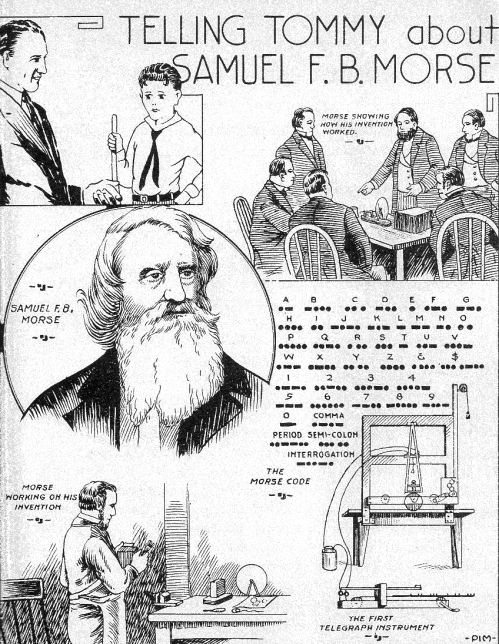
Samuel Morse illustration page – “Telling Tommy About Famous Inventors, p. 49.
In each book, Pim would write a one page introduction to the volume. This would be followed by short easy to read essays about famous people, events, inventions or countries. On the facing page he would produce five or six illustrations, in the style of Ripley’s Believe it or Not, which would usually include a portrait, and several action illustrations. In the “Good Neighbors” book, these illustrations would include a map of the country and pictures of local birds or plants.
Pim died in Birmingham on July 26, 1950 and is buried in the Forest Hills Cemetery. Recently the Birmingham History Center acquired six of the “Telling Tommy” books from a private collector. We are looking for his last book “Telling Tommy About Pilgrim’s Progress” to complete the set.
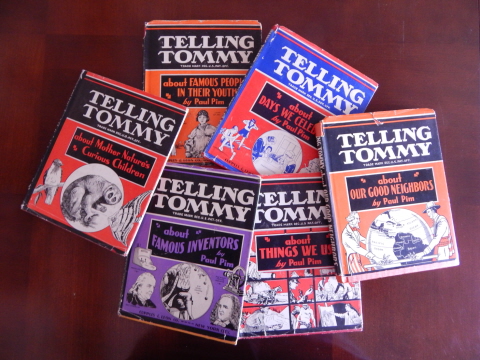
March Forth – Take Small Steps, Don’t Look Down
March 4, 1986 began much like any other Tuesday in Birmingham, Alabama. The weather was cloudy with a light breeze gusting occasionally up to 16 miles per hour. By mid-day the temperature was supposed to reach about 55 degrees, pretty normal for this time of year. As Birminghamians read their morning paper (at the time the city had daily morning and evening papers), the Birmingham Post Herald, in the 5th year of Ronald Reagan’s Presidency, they learned that the Soviet Union’s space probe Vega 1 was approaching Halley’s Comet. After a stop near Venus the probe was sending back the first close-up photographs of the comet’s return to the solar system. Its last visit had been in 1910. NASA had planned to follow up with its own probe as the Earth moved closer to the comet’s orbit but all space projects had been put on hold following the explosion of the space shuttle Challenger in January.
In other news on this day, the U.S. Congress was busy passing important legislation. Representative Jonas Frost of Texas introduced a resolution proclaiming March 4, 1986 as “National Electronics Technicians Day.” On a sad note, Howie Greenfield, a popular songwriter, had passed away from complications due to AIDS. Greenfield was famous for writing the lyrics for the number one hit “Breaking Up is Hard to Do” for Neil Sedaka, then completely changing his tone by writing the lyrics for “Love Will Keep Us Together” for the Captain and Tennille. “Pretty in Pink” starring Molly Ringwald was playing in local theaters and the number one song on the radio was “Kyrie” by Mr. Mister.

The Walk, March 4, 1986, 200 feet above First Avenue North
However, most local citizens of the city did not know that something unique was about to happen downtown on First Avenue North. The Birmingham Area Chamber of Commerce had been looking for a way to advertise its upcoming 100th anniversary and increase its membership. The Chamber had been established 99 years previously in 1887, holding its first meeting at the O’Brien Opera House. After many years at the Lincoln Life Building on First Avenue North (now the Jemison Flats), the Chamber had purchased the Protective Life Building in the mid-1970s, an interesting combination Art Deco/Gothic 14-story structure located on the southwest corner of First Avenue North and 21st Street (now Richard Arrington Boulevard).
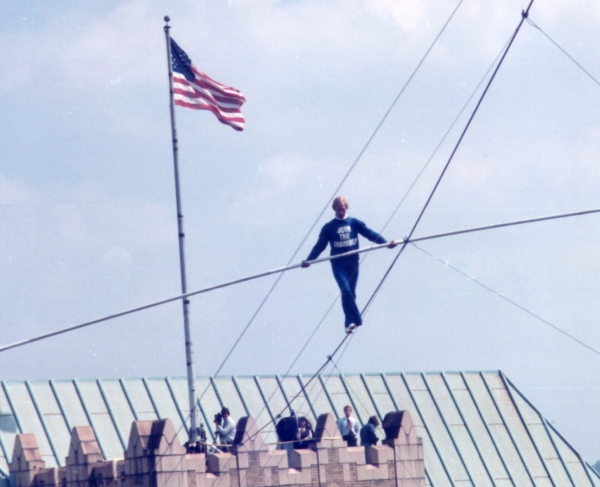
Beginning the walk from theCommerce Center roof (photo courtesy of Michael McKerley)
The Chamber had hired Jay Cochrane, a Canadian tightrope entertainer, to walk a cable strung between the 168 foot tall Commerce Center building to the 210 foot tall Brown-Marx building at the northeast corner of 1st Avenue and 20th Street. After running away from his home in Ontario at the age of 14, Cochrane’s tightrope walking career almost ended before it started when in 1965, a tightrope 88 feet high at Varsity Stadium in Toronto collapsed. He suffered a broken pelvis, two broken legs and other fractures and was told he would never walk again. Recovering by 1986, Cochrane had not yet achieved fame as a premier funambulist (one who performs on a tightrope) in the mode of the Flying Wallendas. But, before his death in 2013 (not a height related end), he would set many tightrope records, including the longest walk (11.8 miles), the highest blindfolded walk (300 feet), and the longest and highest combined skywalk (2,098 feet long and 1,340 feet high over the Yangtze River gorge in China). Previous to his walk in Birmingham, he had set the longest time on a wire record (21 days in San Juan, Puerto Rico in 1981).

Halfway across (photo courtesy of Michael McKerley)
His walk in Birmingham would be a piece of cake by comparison. With a town crier announcing the stunt to a small crowd of about 200 people, including a high school band, Cochrane stepping out of a white limousine, dressed in a bright blue shirt with “Join the Chamber” written on the front. After stating that is was “a nice day for a walk,” he briskly stepped to the Chamber Center door and took the elevator to the roof of the building. There he found a cable and wire supports connecting the building to the Brown-Marx building 300 feet away. Picking up his 30-foot long, 40-pound balance pole he stepped out. Halfway across, he stopped, balanced the pole on one knee and waved to the crowd below. He then continued. The entire walk took seven minutes. And that was it, just another Tuesday in Birmingham, Alabama.
One Game – One Inning
It had been a tough outing for Charley Robertson, pitcher. The Cleveland Indians had already scored four runs off him on nine hits and three walks on this beautiful baseball day at Chicago’s Comiskey Park, May 5, 1922. The score was 4 – 0, and the White Sox manager, “Kid” (William Jethro) Gleason, desperately needed a pitcher to stop the bleeding in the next inning. He sent in Eddie Mulligan to pinch hit for Robertson in the bottom of the sixth inning and peered into the dugout for a pitcher to take the mound in the top of the seventh. He saw Elmer Cox (at least that was what he thought his name was, his real first name was Ernest). Cox, a 28-year-old rookie had not been with the team that long, in fact, this was going to be his first appearance in a major league game – “Warm up kid, you’re going in.”
The White Sox had fallen into hard times. After making it to the World Series in 1919 and posting another great year in 1920, their best eight ball players had been banned from the game for life when the “Black Sox” game-fixing scandal story broke that year. Those ball players, among them “Shoeless” Joe Jackson and ace pitcher Eddie Cicotte, had taken money to lose the World Series to the Cincinnati Reds. In 1921, with a bunch of replacements, the White Sox dropped to next to last place in the American League, beginning a span of fifteen years of finishing fifth or worse (they would not make it back to the World Series until 1959).
Ernest Thompson Cox, had been floating around the minor leagues for some time before getting a chance with the White Sox. Born in Birmingham, Alabama on February 19, 1894, he had won 25 games and lost only 11 in two seasons with the Charleston Sea Gulls of the South Atlantic League in 1916 and 1917. He also pitched in 14 games for the Richmond Colts of the Virginia League in 1919. While at Richmond he was a teammate of “Chief” (Charles Albert) Bender, legendary pitcher and future Hall of Famer. Bender was at the end of his career having won 212 games in the major leagues. He is credited with inventing the slider, known then as the nickel curve. In 1919, Bender had one of the greatest minor league records at Richmond, winning 29 games and losing only 2, with an earned run average of only 1.06 (giving up slightly over 1 run every 9 innings). One wonders how much of an influence Bender had on Cox, maybe he taught him how to throw a slider, but after a few years out of the game, now Cox was going to get a chance in the “Bigs.”
As he went out to the mound White Sox assistant coach, Johnny Evers (Hall of Famer), shouted encouragement, “Go get’em Elmer.” First up to bat was Indians second baseman, Bill Wambsganss. Wambsganss was not a great hitter, his claim to fame being he was the first (and only) fielder in World Series history to record an unassisted triple play. Fighting nerves, Cox walked him, not being pleased with several close calls by home plate umpire Billy Evans (another Hall of Famer). The next hitter was Tris Speaker (Hall of Fame). Speaker was one of the greatest hitters in the first half of the 20th century. With a career batting average of .345, the “Grey Eagle” still holds the major league record for most doubles at 792. Perhaps a little intimidated, none of Cox’s pitches came close to home plate. With runners on first and second, now he had to face Lou Guisto, pinch hitting for Stuffy McInnis who had been ejected from the game in the fifth inning by first base umpire Dick Nallin for arguing after being called out on a close play at the base.
Guisto hit a lazy fly ball in the spacious foul territory at Comiskey Park, an easy play for leftfielder Bibb Falk, but Falk dropped it for an error. With a second life, Guisto then lifted another fly ball that was caught by the more sure handed center fielder, Amos Strunk, but Wambsganss tagged and went to third. One out. On the next pitch, Speaker took off for second while Wambsganss sped home on a perfectly executed double steal. One run in. Indians shortstop Joe Sewell (born in Titus, Alabama and another Hall of Famer) grounded out to second base. Two outs. Indians third baseman Larry Gardner then singled, driving in Speaker from second base. Two runs. Gardner then stole second but “Smoking Joe” Wood, the Indians right fielder (another Hall of Famer) then popped out in foul territory to the catcher for the third out. Final tally in the inning – 2 walks, 1 hit, 2 runs, 3 stolen bases and 1 error (and 5 Hall of Famers).
 And that was it. Cox never played in another major league game. One inning, maybe 10 minutes total with an element of bad luck. If Falk catches the foul ball, Wambsganss stays at second, there is no double steal, Sewell then grounds into a double play, inning over, career not over. That’s baseball, that’s the breaks. Cox returned to live the rest of his life in Birmingham, dying at the age of 80 in 1974. He is buried at the Forest Hills Cemetery, there is no mention of his major league “career” on his tombstone.
And that was it. Cox never played in another major league game. One inning, maybe 10 minutes total with an element of bad luck. If Falk catches the foul ball, Wambsganss stays at second, there is no double steal, Sewell then grounds into a double play, inning over, career not over. That’s baseball, that’s the breaks. Cox returned to live the rest of his life in Birmingham, dying at the age of 80 in 1974. He is buried at the Forest Hills Cemetery, there is no mention of his major league “career” on his tombstone.
Tally-Ho
One of my favorite TV shows from the late 1970’s was a BBC series called “Connections.” Hosted by science historian James Burke, the show explores an “Alternative View of Change” (the subtitle of the series) that rejected the conventional linear view of historical progress. Burke contended that one cannot consider the development of any particular piece of the modern world in isolation. The modern world is the result of a web of interconnected events, each one consisting of a person or group acting for reasons of their own motivations (e.g., profit, curiosity, religious) with no concept of the final, modern result to which the actions of either they or their contemporaries would lead.
The History Center has an object in its collection which stands in the middle of just such a connection. The Tally-Ho carriage is the forerunner of the open-top touring bus. Our Tally-Ho is actually a replica of the type used, somewhat coincidentally, as a touring carriage on the route between London and Birmingham in England in the late 19th century. It has seating for @10 customers. It is the type of carriage that is also known as a “four-in-hand,” in which one driver can control four horses. As you can see from the photograph, our carriage has the usual dashboard in the front (to keep mud and dirt from “dashing” onto the driver and passengers – today’s automobile dashboards do not need to provide that function thankfully), the smaller wheels in the front to allow a wider turning radius, and a rumble seat in the back (also known as a mother-in-law seat or dickie seat in England, Dicky being a popular servants name in the 19th century).
But our connection is not from horse drawn carriage to double-decker bus. It is from the China tea trade to men’s neck wear. Tea was first introduced into Europe by the Portuguese in the 16th century and for many years they held a monopoly on the trade. By the 18th century the British had managed a foothold in the tea trade by introducing the plant in India. Some of that tea ended up in Boston harbor, but that is a different story. By the 19th century the demand in America and England for tea had increased dramatically. The problem was the length of time it took to bring the tea halfway around the world to markets. This lead to the invention of the super fast Clipper ships of the 1840s. With a sleek design the clippers could cut the transit time almost in half, using a great deal of square-rigged sails, the most efficient type of sail for running downwind. In order the secure these sails, sailors invented a new type of knot known as a buntline hitch, a type of knot that is almost impossible to untie under a heavy load.
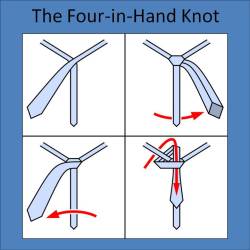
Which brings us to the Tally-Ho carriage. In order for a driver to control four horses, the reins had to be tied together with a very strong knot. The sailor’s buntline hitch was adapted and renamed the “four-in-hand” knot. Members of a riding club in London, known as the Four-In-Hand Club, began wearing their ties using the knot making it a fashion statement. It remains the most popular method for tying men’s ties to this day.
The Middle Toe of the Right Foot
Ambrose Gwinnett Bierce (1842 – 1914?) was an American journalist, author and satirist, famous mostly for his short story “An Occurrence at Owl Creek Bridge” and an immensely funny and satirical lexicon, The Devil’s Dictionary. (A couple of my favorite definitions from his dictionary – Conservative (n.) A statesman who is enamoured of existing evils, as distinguished from the Liberal, who wishes to replace them with others; Marriage (n.) A household consisting of a master, a mistress, and two slaves, making in all, two).
His style often embraced an abrupt beginning, dark imagery, vague references to time, limited descriptions, impossible events and the theme of war. In 1913, Bierce traveled to Mexico to gain first-hand experience of the Mexican Revolution. While traveling with rebel troops under Pancho Villa, he disappeared without a trace.
In 1890, he published a remarkable and gruesome short story entitled “The Middle Toe of the Right Foot.” In the story two men agree to fight a duel with knives in a completely darkened room. It was based on a true story. While working as the star reporter of the San Francisco Examiner, a William Randolph Hearst newspaper, he noticed an interesting report dated November 14, 1888 with a byline posted from Birmingham, Alabama.
This incident was also reported in The Shelby Sentinel of Thursday, November 15, 1888.
Murder At Montevallo. Saturday was a bloody day in Montevallo. W.W. Shortridge, a lawyer there, was frightfully cut, and young Bob Nabors, son of Mr. French Nabors, was murdered. The following are the facts as near as can be ascertained: Shortridge and Bob Nabors were both drinking. They went to the rear of Cary’s law office, and there got into a fight. No one went in to separate them, and they fought til exhausted. When Nabors came out Shortridge was taken up, and was found to have very serious injuries about the head and neck, one or two arteries being cut, and his head bruised so he could scarcely be recognized. Bob Nabors walked on up the street, and passing a negro store he grabbed at a negro boy named “Muss” Keenan. The negro stepped back into the store and Nabors caught at him again. The negro then grabbed a gun lying on the counter and dealt him a blow on the head, fracturing the skull just above the temple. The negro then run, and was pursued by several and shot and once, but he managed to escape, and has not been heard from. Nabors was taken to a private house and had immediate and skillful attention, but never regained consciousness, and died in a few hours. He was buried on Sunday eveniong.
Mr. Nabors was buried in the Montevallo Cemetery. No word of Mr. Shortridge’s final resting place has ever been reported. Albert Keenan is still missing, as is Ambrose Bierce.
For an online reading of Bierce’s short story go to http://www.classicreader.com/book/1943/1/.
Memory mashup–Homewood seniors pen and peddle a new book
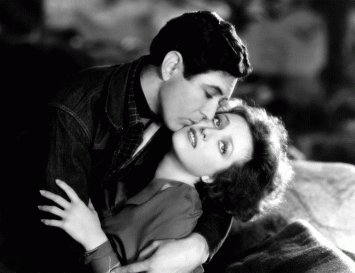
Former Crimson Tide half-back Johnny Mack Brown and Joan Crawford publicity shot for the film, Montana Moon.
His film career would descend to low-budget westerns in the 1950s, but Dothan’s Crimson Tide running back Johnny Brown was a Hollywood leading man for decades.
His dashing good looks led him in 1927 to a role opposite Mary Pickford in her first “talkie “and on to major studio contracts and roles alongside John Wayne, Joan Crawford and Clark Gable. Some time after his 1969 Alabama Sports Hall of Fame induction, Brown picked up the phone to call a fan seeking his autograph. Forty-five years later, Bob Nelson remembers that call in a chapter of Proceeding Over the Mountain, a collection of personal memories by members of the Homewood Senior Center.
“I saw him on TV giving the acceptance speech, one of the finest I’d ever heard…his eloquence and genuineness struck me,” Nelson writes.
Nelson is one of 40 authors who have contributed 88 stories, most of them less than 1,000 words each, that capture emotional and sometimes historically significant memories from their personal pasts. What started as an extra-curricular activity soon spawned a writing class, editorial debates, and new perspectives into each others’ lives, said Center Director Aimee Thornton.
“I was amazed by the variety of stories and the topics,” she said. “People were willing to talk about things I wouldn’t think they’d even be involved in.”
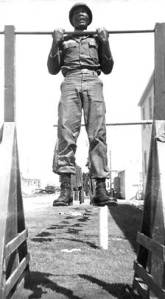
Bennie Charles in paratrooper training. Charles befriended Elvis Presley during basic training in Ft. Hood in 1958.
In “The King and I,” member Bennie Charles recalls being drafted in 1958 and completing basic training in the Second Armor Division at Ft. Hood, Texas, with fellow inductee Elvis Presley. Charles said Presley hung out with the regular guys, using his special allowance of a personal car to take them on weekend day trips, and once to Tijuana. Presley—who had 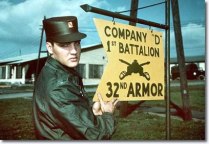 just finished filming the movie King Creole—was frequently recognized and would perform songs just for the asking. The famously generous singer “always insisted on picking up the tab,” Charles writes. “I never had to pay for anything.”
just finished filming the movie King Creole—was frequently recognized and would perform songs just for the asking. The famously generous singer “always insisted on picking up the tab,” Charles writes. “I never had to pay for anything.”
Charles, who is black, tells in another story how he traveled from Pittsburgh to Ft. Hood by bus with 12 white inductees, who elected him “captain” to shield him from any racial incidents in the deep South. Presley, he said, also showed no signs of racial or social prejudice.
“I was proud to call him a friend—he was almost like a brother; he never showed any sign of prejudice toward anyone.”
Overhearing so many stories—some of them startling—during the course of her work gave Thornton the idea for the book. The stories tend to fall into two categories, historically accurate retellings, such Frances Carter’s World War II account of modifying B-29 fuselages for the home front, in Rosie the Riveter, or personal narratives about childhood and teen years.
Many hark back to rural and austere scenes of the Depression: sewing flour-sack dresses, snaring rabbits and fish for food, wearing a “fat back” poultice, and preparing hominy from corn washed with lye.
In contrast, author Jackie Hoffman recounts the national treasures she passed on her way to grade school in Newport, Rhode Island: The first United States lending library, the Touro Synagogue, oldest in the nation, and St. Mary’s church, where JFK in 1958 married Jackie.
Others tell about a first kiss, a stint at reform school, forbidden honky tonks, and a missionary’s tale of remaining pure (with difficulty) in a cross-country trip with a beautiful female colleague.
In one expertly told story well under 300 words, Betty Mann tells how her husband, who is deaf and was signing a Sunday school lesson one warm morning, reached in his jacket for a handkerchief and pulled out a pair of her panties instead.
“Most of the stories were written; but many others were dictated,” said Thornton, who contributed her own stories, one about her grandfather. “I take after my granddaddy, who was gregarious. I like to hear stories and tell them,” she said.
Member and contributor Carolyn Roberson collected the stories and Thornton was editor. The project took nearly three years, in which Bobbie Hunt, 89, the writing instructor and the book’s most prolific contributor, said she didn’t think she’d live to see it published. That day arrived [publishing day].
Paperbacks are $14, with a signing event scheduled Feb. 20 at 11 a.m. at the Homewood Public Library. For more information or to purchase a copy, call the Homewood Senior Center at 205-332-6500.
1885 City View Map
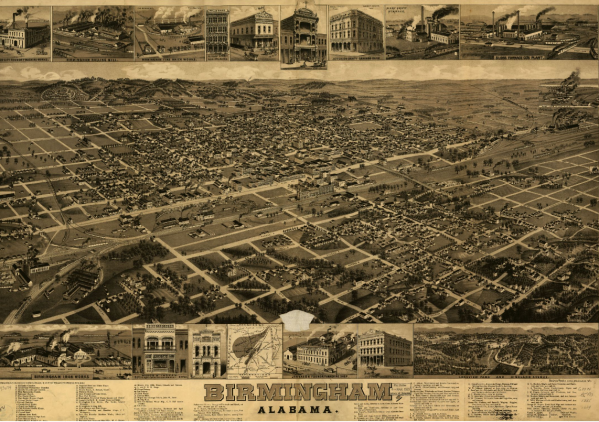 Americans in the late 19th century collected and enjoyed lithographs, especially if the image depicted a favorite topic such as historic figures (Abraham Lincoln and George Washington were the most popular), famous naval or land battles, public buildings, sailing ships, patriotic tableaux, natural wonders, and sentimental scenes of family or holidays. Invented by a Frenchman in the late 18th century, the most common method of lithography (from the Greek “lithos,” meaning stone and “graphein,” meaning to write) was to etch an image on a smooth treated limestone plate, a method much easier and cheaper than woodblock or letter press printing. Today most lithographs are made by applying a polymer coating to a flexible aluminum plate, usually with the etching designed with the aid of a computer.
Americans in the late 19th century collected and enjoyed lithographs, especially if the image depicted a favorite topic such as historic figures (Abraham Lincoln and George Washington were the most popular), famous naval or land battles, public buildings, sailing ships, patriotic tableaux, natural wonders, and sentimental scenes of family or holidays. Invented by a Frenchman in the late 18th century, the most common method of lithography (from the Greek “lithos,” meaning stone and “graphein,” meaning to write) was to etch an image on a smooth treated limestone plate, a method much easier and cheaper than woodblock or letter press printing. Today most lithographs are made by applying a polymer coating to a flexible aluminum plate, usually with the etching designed with the aid of a computer.
Lithographic printing came to the United States in the 1820s. It soon dominated the market for popular prints. One of the most popular categories of lithographs became city views. At first these views were from street level, but soon it became popular to portray settlements from an imaginary viewpoint high in the air. These lithographs would also usually include number legends or keys, passages of descriptive text, and detailed vignettes of important buildings.
As many as 2,500 city view lithographs were produced in America in the period between 1835 and the early 20th century when the fad finally ended. Many lithographic artists, such as Edwin Whitefield, T. M. Fowler, and O. H. Bailey, produced hundreds of city view lithographs. Large and small cities and even small towns and hamlets were depicted, making it truly democratic. However, since this was a purely commercial venture, this art form was largely ignored by art critics, until recently. Today, an original city view lithograph can sell for up to $10,000.
The usual procedure was that a roving agent of the lithograph company would visit a city and sell subscriptions to local businessmen and prominent citizens, often soliciting support from local newspapers. They would stress that this project would be a point of city pride, that other rival communities in the area had already done this and that the final product would be a splendid addition to any wall or business board room. It would also prove to the rest of the country how attractive and prosperous the city had become.
For a larger fee, a business could have its image enlarged around the edges of the city view. A smaller fee would get the business on the numbered legend at the bottom of the print. Then the artist would come to town. He would prepare a city street and avenue grid and make hundreds of sketches of buildings and public areas, noting their locations. From these rough drawings he would produce a more detailed and attractive drawing which would then be sent to a printer.
In 1885, Henry Wellge of Norris, Wellge and Company of Milwaukee, Wisconsin came to Birmingham. One of the best view makers in the country, Wellge was born in Germany in 1850. Rumors were that he had once been a captain of engineers in the Russian army although never proven or denied by Wellge himself. He began making city views in 1878. Over his career, which ended with his death in 1917, he produced over 150 views of cities from across 26 states and Canada. His most prolific year was the same year he visited Birmingham. That year he also completed 10 cities in Wisconsin, 6 cities in Florida, 4 cities in Georgia and 1 city in Texas for a grand total of 22 cities.
His 1885 view of Birmingham is one of his best. Looking across the city to the west from a point high in the air, the image centers on 20 Street and First Avenue North. It is surrounded by 16 larger drawings of sponsor buildings and maps. The legend includes 81 additional city businesses with corresponding numbers on the map. Interesting details emerge including the rail line, the first city school, Capital Park (now Linn Park) and a proposed hotel and depot that was never built near the rails at 20th Street. The upper right corner of the view shows Sloss Furnace which had just been built while the Birmingham Rolling Mill is shown at the lower left corner. It is an amazing snapshot of a growing, booming city.
Wanted: Stenographers skilled in shorthand. Others need not apply.
Author’s note: Herein is a very brief history of shorthand followed by two instances in which the dying or lost art has interfered with deciphering historic documents, some which may be important, and others which may be only fun.
Writing is hard.
No, not just composing, that’s definitely hard. What I’m talking about is the physical act of writing, of making letters and words fast enough to capture the lightning speed of one’s thoughts. Or, harder still, to accurately and “discreetly” record another person’s speech, which flows at an average of three words per second. Because this is the original reason for developing shorthand—not to take dictation or jot notes accurately in English class—but to record, precisely, conversations that one intends to put to use later.
Long before texting, the proliferation of at least 500 major English-language “shorthand” systems since the Renaissance attests to the importance of spreading accurate gossip.
Two of the most important systems historically are the British Pitman System, developed by Isaac Pitman in 1837, followed in 1888 in the United States by John Robert Gregg’s simplified system. Both use symbols that indicate common speech sounds. In the literal hands of an expert stenographer, more than 200 words per minute can be taken down with no more technology than a pencil and pad– more than the 180 words produced by an average speaker. Compare that to the typical 22-words-per-minute achieved by handwriting.
(Interestingly, Pitman’s brother Benn, who served in the Union Army of the Civil War, popularized and used the shorthand later as the government’s official court stenographer during the trials of President
Lincoln’s assassins.) Gregg’s shorthand doesn’t have many adherents while Pitman’s system has endured in part due to the British legal system, where shorthand records–but not tape recordings–are admissible as defense evidence in journalism libel cases.
Still, with the advent of stenography machines and audio recorders, shorthand is at best a dying art. So few are the practitioners, in fact, that important top secret documents may be safely left lying open on a desk so long as they are recorded in shorthand.
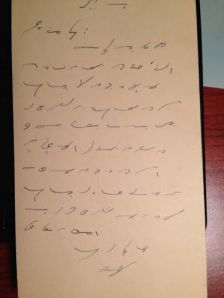
This postcard from Wilford Pierce to his teenage girlfriend conveyed a private message in shorthand. What did he say?
Unfortunately, as sometimes happens, historians do get their hands on those documents and need to find a translator. That is precisely what happened some years ago when documents were uncovered that recorded the secret 1962 Birmingham Chamber of Commerce meetings held to negotiate an end to racial segregation and street protests. Among the typewritten minutes of the famed “Senior Citizens Committee,” meetings turned over to the Birmingham Public Library was a steno pad written in shorthand that remains untranslated to this day.
Here at the History Center is another example. A year ago the center received a donation of 46 letters written in 1938-1940 by a Gorgas power plant clerk to his teenage girlfriend in Birmingham. The couple met taking classes at Wheeler’s Business College in Birmingham. Frequently throughout the 18-month correspondence, the writer uses shorthand to convey a private message.
What do the messages say? What is recorded on the steno pad? Anyone wanting to help translate, please reply to this blog or call the office at 205-202-4146.
Sources:
Beside the ubiquitous Wikipedia articles on shorthand, information was drawn from the Birmingham Public library archives, Birmingham Chamber of Commerce Senior Citizens Committee Papers, 1963.
Digging Pennsylvania History, the Benn Pitman House http://www.diggingcincinnati.com/2013/01/the-benn-pitman-house.html
Leah Price Diary: The Death of Stenography in the London Review of Books, 2008, http://www.lrb.co.uk/v30/n23 Jennifer Schuessler/leah-price/diary
A Brief History of Shorthand, by Jennifer Schuessler, New York Times.com http://artsbeat.blogs.nytimes.com/2009/08/06/a-brief-history-of-shorthand/?_r=0
The shorthand Place, with link to chart of 500+ systems; http://www.t-script.co.uk/history.php
And for fun, the blog by Beryl Pratt, Long Live Pitman’s Shorthand http://long-live-pitmans-shorthand.blogspot.co.uk/
Avondale underground–digging up a story, if not a history

Found on Saturday, Oct. 25, 2014 at Avondale Park. Is it a Civil War relic from Birmingham’s only recorded skirmish, or something more mundane?
There’s nothing like a buried, rust encrusted iron ball found in a local park to cause a stir, especially among history buffs. And there are no amateur historians more engaging— and engaged — in their work than those in the ranks of local metal detectors. When they are not scouting loose change from our beaches, they can be found in our parks, our wooded buffers and public right-of-ways monitoring their instruments and sometimes detecting relics of our forgotten past.
So it is with this historic find from Avondale Park in a picture submitted by metal detector Tate McNees. McNees has undoubtedly unearthed an historic piece of ammunition – if not a ball bearing—of some kind. But can he attach it to an historic event?
He can.
McNees and other devotees of Birmingham history will nod when reminded that on land now Avondale Park Union shots were fired and a casualty recorded during the waning years of the American Civil War. Bhamwiki.com’s Battle of Avondale post has summarized two published references to this sole Birmingham claim to a civil war casualty:
In the 1885 weekly, Iron Age, a story published 20 years after the 1865 incident, the wife of Jefferson County Sheriff Abner Killough was hit by accidental “friendly fire” while at her house on the property that later became Avondale Park. It was here that Union Army officers, as non-aggressors innocently stopping by after watering their horses, were mistaken as marauders by the local 10th Alabama Infantry, which fired—hitting only Ms. Killough.
In the 1893 Birmingham Age Herald account, the Alabama guard is already stationed near the house when it spies and fires upon the Union officers at the spring–“their rifle balls hitting the water like hail”– who promptly returned fire, hitting Ms. Killough.
In both accounts, the exchange goes no further and Ms. Killough recovers.
McNees suggests that the artifact found at the park is a “grape shot,” so named because such iron balls were bundled in grape-like clusters before being fired in a spray of shrapnel by cannon or other artillery.
If this not a piece of grape shot, could it be a “rifle ball” associated with the skirmish, or some other object entirely? Here’s another take on the Killough story.
It’s an interesting find, and thank you Tate McNees for showing it to us.



